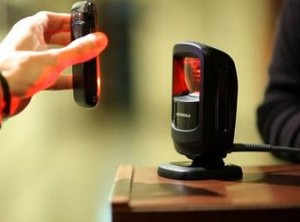Reading Honeywell Scanning & Mobility’s recent white paper, Mobile Marketing: Retail’s Next Frontier, caused me to consider my own susceptibility to mobile coupons, and I was surprised to realize that I do, in fact, use them regularly.
For example, Cinemark Theaters emails a weekly coupon and, although I don’t go to the movies weekly, when I do attend I’m likely to choose a Cinemark theater over its nearest competitor if only because I’ll save a few dollars on popcorn or soft drinks thanks to its mobile coupons. I simply display the coupon on my smartphone, and the snack-bar clerk credits the discount at checkout.
 And I’m not alone. A December 2009 survey conducted by Harris Interactive found that 46 percent of adults considered themselves likely to redeem barcoded coupons delivered to their mobile phones. One third of adults described themselves as likely to share their mobile phone numbers to receive such coupons, and that percentage increased to fully 50 percent among the segment of adults ages 18 to 34.
And I’m not alone. A December 2009 survey conducted by Harris Interactive found that 46 percent of adults considered themselves likely to redeem barcoded coupons delivered to their mobile phones. One third of adults described themselves as likely to share their mobile phone numbers to receive such coupons, and that percentage increased to fully 50 percent among the segment of adults ages 18 to 34.
Further findings included:
- 90 percent of adults owned a mobile phone;
- 86 percent of adults reported that they had in the past redeemed traditional paper coupons;
- 90 percent of adults with incomes ranging from $35,000 to $75,000 had previously redeemed some form of coupon, which percentage was even higher among those who earned $50,000 or more; and
- 56 percent of survey respondents who were willing to share their mobile numbers in order to receive coupon offers reported that they would prefer to log in regularly to a website to choose which coupons were sent to their phones.
Experience shows that potential customers who engage in the active step of making coupon selections are more likely to actually use those mobile coupons than they are coupons that they receive at random.
Of course, the iPhone-sparked smartphone revolution was barely 2.5 years old when this survey was conducted, and it’s safe to assume that potential readiness to accept mobile coupons is even greater today, if only because of the greater overall focus on mobile communications and computing.
Some closing tidbits: According to eMarketer, by 2016, 74 percent of U.S. mobile-phone users are expected to own smartphones. Per Nielsen, the most common activity in which mobile-phone users engaged while in brick-and-mortar retail stores was collecting vouchers for credit at checkout, and more mobile coupons were redeemed at grocery stores than in any other category of retail outlet.













